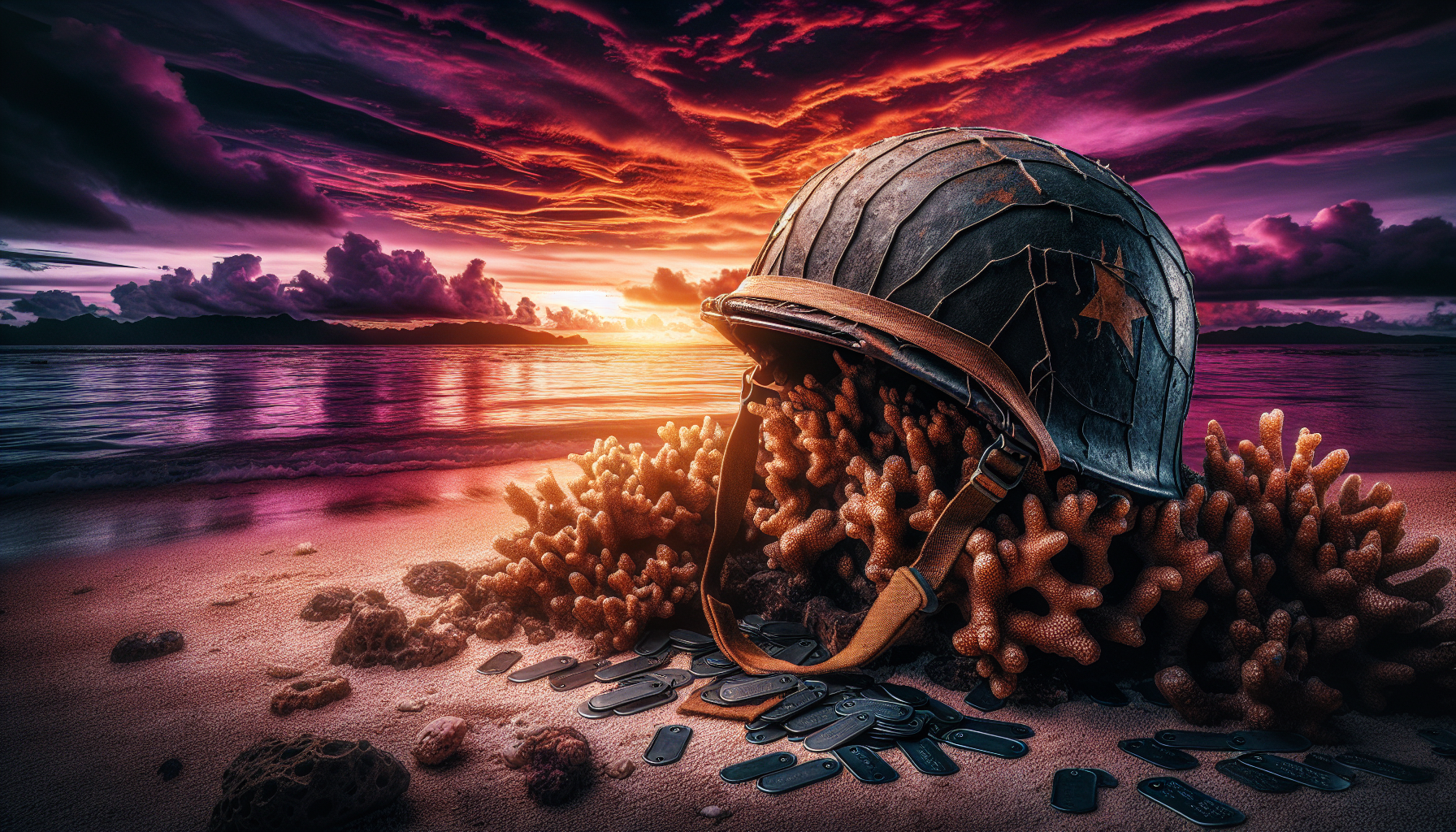In September 1944, the United States 1st Marine Division embarked on a perilous mission to capture the strategically significant island of Peleliu in the Pacific Theater of World War II. This operation represented a critical yet contentious chapter in military history, as numerous American commanders expressed doubts regarding its necessity and feasibility. Despite the controversy, the assault commenced, leading to devastating casualties on both sides, particularly among the Marines, many of whom faced seasoned Japanese defenders employing innovative tactical strategies.
This article examines the Battle of Peleliu, analyzing the operational decisions that defined the conflict and the broader implications it had on the Pacific Campaign. By assessing the strategic objectives, the resultant human cost, and the contentious debates surrounding the operation’s value, a clearer understanding emerges of Peleliu’s role in World War II and its lasting legacy in military strategy.
The Battle of Peleliu: A Comprehensive Analysis

Historical Background
Overview of the Pacific Theater in World War II
In the vast tapestry of World War II, the Pacific theater emerged as a critical stage where the United States and its allies faced the Japanese Empire. Characterized by numerous amphibious assaults and intense ground battles, this theater was fueled by ideological differences and a fierce struggle for territory. Major campaigns unfolded on various islands, each contributing to the broader strategy of “island hopping,” which sought to reclaim territory from Japanese control and establish a presence closer to the Japanese home islands.
Significance of Peleliu in the Broader Context
Peleliu, a small island in the Palau group, was strategized as a pivotal target in the overarching campaign to secure the Philippines and ultimately Japan. Its capture would not only disrupt Japanese supply lines but also serve as a launch point for subsequent operations. The Battle of Peleliu was deemed crucial by military planners, despite its small size and limited strategic resources, as it provided a necessary foothold within striking distance of Japan.
Previous Battles Leading to Peleliu
Prior to the invasion of Peleliu, significant battles had unfolded across the Pacific, notably battles at Guadalcanal, Tarawa, and Saipan. These encounters revealed the fierce tenacity of Japanese defenses and the evolving strategies of American forces. Each battle sent ripples through command strategies and troop morale, shaping the approach the U.S. would take upon reaching Peleliu. Lessons learned from these earlier confrontations led to the application of advanced combat tactics and heightened reconnaissance efforts.
Geographical Significance of Peleliu
Strategic Location of Peleliu
Peleliu’s geographic location, positioned approximately 500 miles east of the Philippines, made it a key stepping stone in the Pacific theater. Control over the island would enable the Allies to secure air and naval superiority, facilitating assaults on other nearby islands and providing essential logistical support for future operations. It was an island not just of physical worth but of symbolic implication in the crusade against Japanese aggression.
Topographical Challenges Faced by the Forces
The terrain of Peleliu posed extraordinary challenges to invading forces. The island’s rugged landscape consisted of coral ridges, which created natural fortifications advantageous to Japanese defenders. The dense jungle and rocky outcroppings enabled veteran Japanese troops to implement intricate defensive strategies. For American forces, traversing this landscape proved difficult, hampering progress and complicating tactical maneuvers.
Weather Conditions During the Battle
The weather in September 1944 added a layer of complexity to the already treacherous conditions on Peleliu. The tropical climate brought heavy rains and oppressing humidity, leading to muddy conditions that impeded movement and visibility. Tropical storms and monsoon conditions further exacerbated the struggle for American forces, complicating logistics and wearing down troop morale.
The Forces Involved
Composition of the US Marine Corps
The United States Marine Corps deployed the 1st Marine Division, a seasoned group of combatants with in-field experience from previous battles in the Pacific. In addition to the Marines, the U.S. Military included army units, artillery, and support personnel. The diverse composition provided a blend of offensive capabilities necessary for overcoming the entrenched Japanese forces.
Japanese Imperial Army Strategies
The Japanese defenders, significantly led by Major General Nakamura, had developed an elaborate methodology for defense based on their experiences in previous confrontations. Their strategy involved a unique combined-arms approach, utilizing pillboxes and concealed positions to create a dense network of fortifications. This method aimed to withstand the onslaught while inflicting maximum casualties on the invading forces.
Role of Supporting Units and Naval Forces
Support units, including naval bombardment and aerial reconnaissance, played a pivotal role during the operation. Naval forces provided critical fire support, while carrier-based aircraft conducted strikes against Japanese positions. The integration of these elements aimed to soften Japanese defenses and facilitate the landing operations. However, despite thorough planning, the effectiveness of these supports was diminished by the island’s topography and Japanese resilience.
Planning the Invasion
Objectives of the US Command
The primary objective defined by U.S. military command was to capture Peleliu rapidly and decisively, thereby securing a strategic base for future offensives. This objective aligned with the broader goal of isolating Japan and undermining its capacity for continuing warfare in the Pacific.
Controversies and Debates Among Military Leaders
Debate among military leaders regarding the necessity of the invasion stemmed from differing perspectives on Peleliu’s strategic value. Some commanders, including Lieutenant General George C. Kenney, argued that resources should be allocated elsewhere, deeming the battle an unnecessary diversion. Nevertheless, the decision to proceed reflected an overestimation of Peleliu’s importance within the larger campaign.
Intelligence and Reconnaissance Efforts
Intelligence gathering leading up to the invasion suffered from inconsistencies and limitations. While initial reconnaissance indicated Japanese defenses, detailed knowledge about troop placements and equipment remained elusive. The challenges of gathering accurate intelligence curtailed the ability of American forces to plan effectively for the amphibious assault.

The Assault Begins
Initial Amphibious Landing on Peleliu
On September 15, 1944, American forces executed their amphibious landing on Peleliu under the cover of naval bombardment. The assault initially faced resistance, yet many Marines were able to overcome beach defenses in near-perfect conditions. Despite this relative success, the true challenges lay ahead.
Immediate Challenges Faced by US Forces
The moment American troops set foot on Peleliu, they confronted fierce Japanese artillery and snipers. The efficacy of Japanese defensive tactics became clear, as waves of Marines quickly faced overwhelming opposition, suffering heavy casualties. The surprise and ferocity of the Japanese resistance countered assumptions regarding an easier conquest.
Japanese Defenses and Tactics
Japanese defenders utilized their knowledge of the terrain to great advantage, establishing a grid of concrete pillboxes interspersed with machine-gun nests. This strategy allowed for overlapping fields of fire and deep enfilading positions, compelling American forces into drawn-out combat operations that exhausted personnel and resources alike.
Key Battles and Tactical Maneuvers
In-Depth Analysis of Significant Skirmishes
The battle encompassed many significant encounters, including the struggle for the airfield and attempts to breach Japanese lines around the Umurbrogol mountain range. Each fight saw tactical adaptations, emphasizing close-quarter combat and teamwork, as American forces learned, sometimes painfully, from their immediate experiences.
US Strategies and Adaptations
As the battle wore on, the American command shifted strategies to adapt to the inhospitable landscape and entrenched enemy forces. The introduction of specialized units, such as flamethrower teams, displayed the flexibility and innovativeness of U.S. military tactics. The willingness to learn and evolve is often credited with gradual successes during the prolonged engagement.
Japanese Counterattacks and Resilience
Despite sustaining significant losses, Japanese forces displayed remarkable tenacity through counterattacks and guerrilla tactics, refusing to withdraw even amidst heavy casualties. This fierce resistance contributed to a prolonged battle that would ultimately last until November 1944, anchoring Peleliu in the annals of military history as an intense confrontation.

Casualties and Human Cost
Detailed Breakdown of American and Japanese Casualties
By the conclusion of the Battle of Peleliu, American forces suffered approximately 9,800 casualties, with around 1,700 killed. Conversely, Japanese military losses were devastating, with estimates indicating that about 10,500 soldiers were killed, and the remainder of forces, approximately 200, surrendered. The stark disparity in figures highlighted the grave human cost that both sides endured.
Impact of Casualties on Morale
The heavy casualties on both sides had profound impacts on the morale and psyche of the troops. Among American forces, the high rate of injury prompted questions about the battle’s purpose and their effectiveness as combatants. Japanese morale, while initially steadfast, experienced strains as the death toll rose and supplies dwindled.
Personal Accounts from Soldiers
Personal narratives from soldiers who experienced the battle capture the horror and chaos they faced. Accounts illustrate the desperation of combat, the emotional toll of observing comrades fall, and the uncertainty of survival. Such testimonies reinforce the battlefield toll beyond mere statistical analysis, revealing the traumatic imprint war has left on individual lives.
Aftermath of the Battle
Immediate Outcomes of the Peleliu Campaign
The immediate outcome of the Battle of Peleliu led to the eventual capture of the island by American forces, securing a vital base of operations. However, the extended conflict drew significant resources that might have been deployed elsewhere, igniting discussions about operational priorities.
Long-Term Implications for the Pacific War
In the broader context of the Pacific War, the costly yet ultimately strategic victory at Peleliu paved the way for subsequent operations, notably the reconquest of the Philippines. The battle became a grim example of the cost associated with certain military objectives, influencing future American engagements.
Evaluation of Tactical and Strategic Lessons Learned
Evaluating the battle yields critical tactical insights regarding fortification defenses and the need for adequate reconnaissance. The lessons learned at Peleliu would be applied to future operations where adaptability and coordination became increasingly paramount for success against entrenched enemy forces.
Controversies and Critiques
Debate Over the Necessity of the Invasion
Despite the eventual capture of Peleliu, many historians criticize the invasion as a costly endeavor that may not have been necessary. Debates center around whether the resources expended here could have been better utilized in other operations that fortified the Pacific War’s overall strategy.
Critical Perspectives from Historians and Military Analysts
Scholars continue to examine the operational efficacy of the Peleliu campaign. Some posit that the potential for securing strategic victories could have been pursued at lesser cost, while others argue that valuable lessons regarding amphibious assaults were learned despite the toll inflicted.
Comparisons with Other Pacific Battles
The Battle of Peleliu is often paralleled with other engagements, such as Tarawa and Iwo Jima, highlighting various degrees of success and lost lives. These comparisons complicate the narrative of heroism and valor often associated with the U.S. Marine Corps, provoking deeper considerations about the morality and strategy behind wartime decisions.
Conclusion
Summary of Key Points Discussed
The Battle of Peleliu stands as a paradox in the Pacific theater, where strategic objectives collided with the harsh realities of combat. Understanding its historical background, geographical significance, and military dynamics reveals a multifaceted conflict laden with both tactical innovation and tragic consequences.
Final Thoughts on the Significance of Peleliu
Ultimately, the significance of Peleliu lies in its dual role as both a victory and a cautionary tale. It served as a critical pivot point while simultaneously highlighting the brutal nature of modern warfare, prompting critical self-examination among military planners.
Reflection on the Lessons Learned for Future Conflicts
Peleliu serves as an enduring reminder of the complexities inherent in warfare—the delicate dance between strategy, ethics, and human costs. Future conflicts would do well to heed the lessons learned from such battles, recognizing the weight of decisions made in the theater of combat, lest history repeat its most grievous mistakes.
